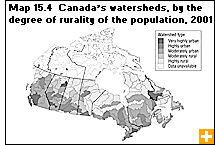Common menu bar links
Watershed pressures
Archived Content
Information identified as archived is provided for reference, research or recordkeeping purposes. It is not subject to the Government of Canada Web Standards and has not been altered or updated since it was archived. Please contact us to request a format other than those available.
A boil-water advisory surprised millions of Vancouverites in 2006 and contaminated drinking water killed seven and sickened hundreds in Walkerton, Ontario in 2000. Such events have generated debate about how best to manage our watersheds.
A watershed is a region of interconnected waterways that function as a single system—upstream activities may affect downstream quantity and quality. Geographers have defined 164 geographic units in Canada called sub-basins. These watersheds are the drainage areas of the smaller rivers that flow into Canada’s major rivers.
In 2001, 10 million people resided in six watersheds, making them our most urban watersheds. These cover just 3% of Canada’s land area. From 1981 to 2001, the population of these watersheds grew 45%, or by three million people. This reflects the urban character of Canada’s population and underlines the pressure on specific fresh water sources and the infrastructures that supply and treat freshwater.
Ontario stands out—six million people reside in just one watershed, covering the greater Toronto area, the Golden Horseshoe and the Niagara Peninsula. In British Columbia, 2.3 million people live in two watersheds covering Greater Vancouver and the Fraser Valley. Another one million reside in very highly urbanized watersheds in Calgary and Fort McMurray, where the oil and gas industry’s water use is raising concerns.
Only 19% of Canada’s entire rural population lives in a watershed where rural residents are the majority. This highlights a challenge facing rural and urban Canadians as they negotiate water-management solutions.



